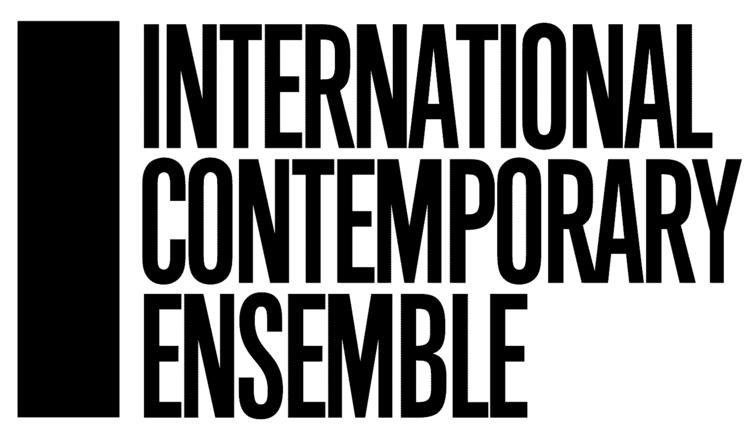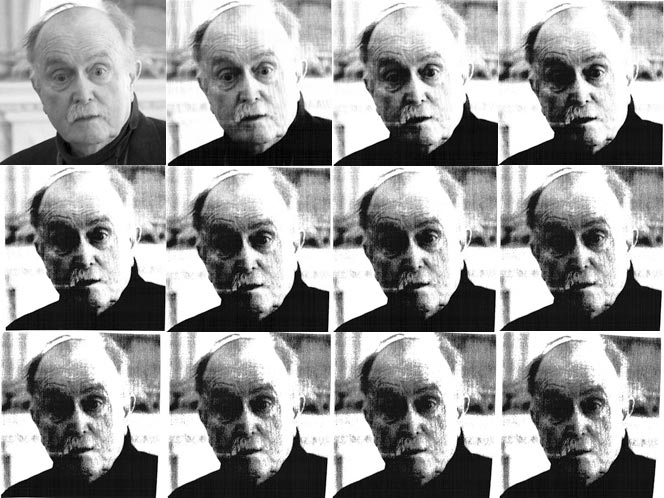Impressions from Row G
by Arlene and Larry Dunn (@ICEfansArleneLD)
photos and collages by Larry Dunn
Three straight evenings of ICE assaying 45 years of Alvin Lucier’s music, with Alvin present and performing, was like diving in crystalline Caribbean waters with the kaleidoscope of colors and textures a feast of sound for the ears, rather than a rainbow riot of fish and coral reef to delight the eyes. This total immersion into Lucier’s sound sea overwhelmed our senses in the fourth floor gallery and atrium at the Museum of Contemporary Art Chicago on March 21, 22, and 23, 2014.
Fittingly, the festival opened with Alvin performing his iconic masterwork I am sitting in a room (1969). With his book Chambers in hand, he entered the room, sat crossed-legged revealing his trademark red socks, opened the book, and read the 105-word text. Through a dozen iterations of recording and re-recording, his spoken words gradually dissolved into pure rhythmic sounds expressing the acoustic qualities of the space. The final iteration sounded like muffled metallic percussion strikes reverberating through water.
Cellist Katinka Kleijn dazzled with Music for Cello with One or More Amplified Vases (1992). Seated among an array of vases of varying size, chosen, placed and mic’ed by sound engineer extraordinaire Levy Lorenzo, Katinka unleashed a continuous stream of tones that excited the vases to vibrate, sending out sonic waves picked up by their mics. The vases’ unique shapes – tall, narrow, short, squat – reacted differently, creating a eerie, quiet cacophony of sound. Katinka initially appeared to be in charge, but as the vases came alive and competed for attention, they seemed to be calling the tune. Katinka’s performance was a tour de force of focused concentration. She never lifted her bow off the cello as she steadfastly elevated the tone, so slowly that her left hand moved down the fingerboard almost imperceptibly.
Sitting in a Room with Alvin, by Larry Dunn
It was aurally arresting to hear Codex (2013), both more ephemeral and more striking, in a vastly different space than when we heard the world premiere in an opulent turn-of-the-20th-century salon at the Americas Society in New York. Seated in front of the resonant four-story atrium, soprano Tony Arnold, violinist David Bowlin, oboist Nick Masterson, guitarist Dan Lippel, clarinetist Josh Rubin, and Katinka unearthed sounds from ancient Peruvian tombs. Tony’s wordless vocalizations were like mourning lamentations over the ancient echoes of a lost, stolen, obliterated culture.
Carbon Copies (1989) makes use of happenstance and improvisation to produce a unique outcome in every performance. Saxophonist Ryan Muncy, pianist Phyllis Chen, and percussionist Ross Karre each made their own field recordings, per the instructions in the score. These environmental recordings were mixed and played back in the performance space as the first section of the work. The players, spread around the room, gradually entered with sparse phrases of improvised sounds, emulating elements of the recorded sound – Ross crumpling and ripping paper, then muffled striking on wood blocks; Ryan spurting toneless blurts mixed with pops, squeals, and percussive key taps; Phyllis chaotically tinkling upper-register keys, plucking and slapping strings inside the piano. Soon, we were enveloped in a complex sound tapestry in which it was hard to discern the recorded from the instantaneous. Then the recordings faded out, leaving only phantom memories, as the improvisers strived to sustain the sound complex on their own.
To bring the festivities to a close, we took one final ride on a Silver Street Car for the Orchestra (1988). Percussionist Nathan Davis gamely took the role of streetcar conductor, armed only with an orchestral triangle and a metal striker. Starting with a tone and rhythm that might have come straight from a San Francisco cable car, Nathan laid down an eight-minute nonstop barrage. He varied the striking spot, placement and extent of left-hand damping, and speed and volume of his strokes, displaying the vast diversity of sound a triangle can make. Our ears are still ringing.




